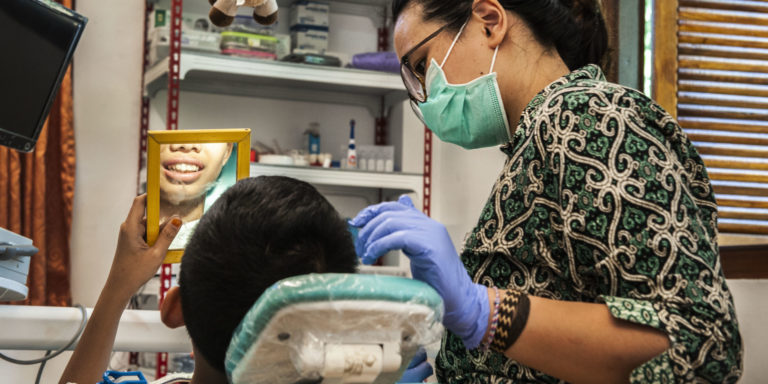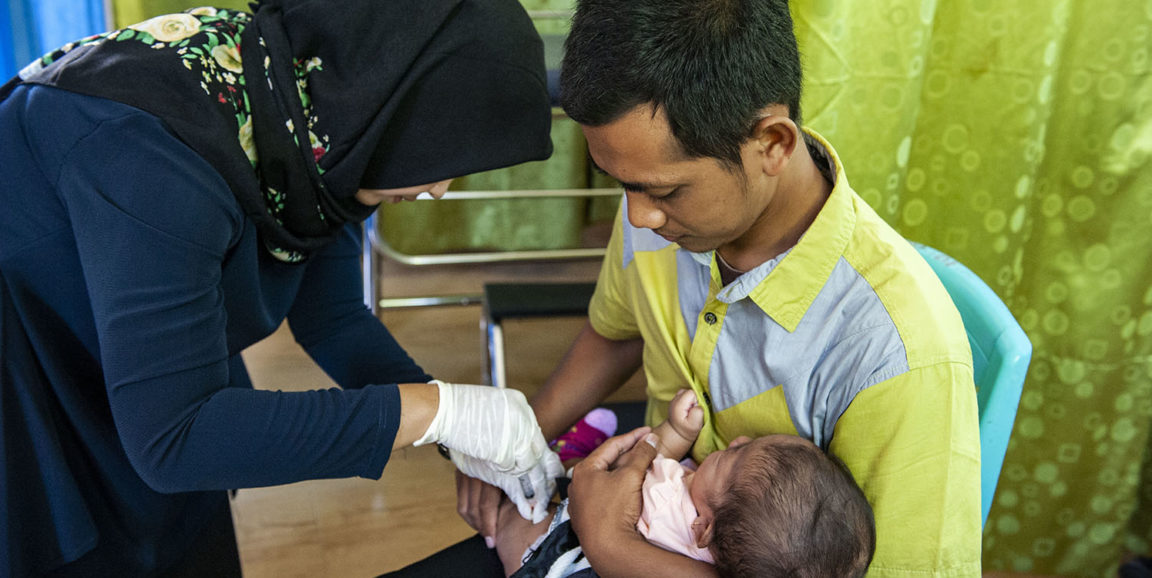Published: 11/11/2020
Photos by Stephanie Gee. Story by Lucas Oliver Oswald.
Back in the mid-2000s, researchers engaged hundreds of people in rural Indonesia in what they termed “radical listening,” in an attempt identify the driving force behind deforestation near Gunung Palung National Park.
After 400 hours of conversation, a common theme emerged: illegal logging was being used as a way to pay for desperately needed health care.
In response to the needs of the local community, a non-profit organization was formed and a health clinic was established.
The hope was to reduce deforestation while improving health in the community — and thus create a meaningful link between human and planetary health. A Stanford-led study, recently published in PNAS, examines the impact of this approach.
The current paradigm for conserving tropical forests – establishing protected areas – often excludes and disenfranchises local communities. This failure to address people’s needs can lead communities with few economic alternatives to illegally log and convert the land.
Read more in the Stanford News Service article.
The researchers evaluated deforestation rates in the national park 10 years after the opening of the clinic, which operated under a non-traditional payment structure. It provided discounts to people from villages that demonstrated community-wide reductions in logging, and it accepted barter as payment in the form of tree seedlings, handicrafts, and labor.
Under that alternative payment system, the clinic treated more than 28,000 people over 10 years, and the community saw a significant case decline in a range of infectious and non-communicable diseases, according to the study.
What’s more, the researchers found that illegal logging had decreased by 70% compared to control sites.
The approach shows promise for simultaneously addressing global health and climate concerns, said Michele Barry, MD, senior associate dean of global health at Stanford and director of the Center for Innovation in Global Health.
“Health and climate can and should be addressed in unison, and done in coordination with and respect for local communities,” Barry, a co-author of the study, said in a Stanford News Service article.
Addressing health care needs and environmental concerns
Indigenous communities manage roughly 30% of the earth’s surface, yet conservation efforts often lack participation from them and local communities. As the article states:
“The current paradigm for conserving tropical forests – establishing protected areas – often excludes and disenfranchises local communities. This failure to address people’s needs can lead communities with few economic alternatives to illegally log and convert the land.”
With the clinic, two nonprofit organizations worked with local communities to create and manage an alternative that addressed their health care needs and environmental concerns.

As the article notes, “Between 1985 and 2001, this region had lost 60 % of its forest to illegal logging.”
The clinic’s payment model appeared to dissuade this activity. Satellite images of the national park revealed that an amount equivalent to more than 6,770 acres of rainforest had been retained, according to the study.
The researchers also found that areas with the most pronounced reduction in logging rates were adjacent to communities whose residents used the clinic most.
Linking the health of humanity and of the ecosystem
Perhaps not surprisingly, the researchers also documented encouraging health trends.
An analysis of health records from the clinic over the 10 year period found significant case declines in several diseases, such as malaria, tuberculosis and diabetes. Some results defied regional trends: For example, cases of tuberculosis and chronic obstructive pulmonary disease had increased in the region over the 10-year period, but declined significantly in communities served by the clinic.
Isabel Jones, PhD, the study’s lead author, said the results were a welcome surprise.
“We didn’t know what to expect when we started evaluating the program’s health and conservation impacts, but were continually amazed that the data suggested such a strong link between improvements in health care access and tropical forest conservation,” she said in the news article.
She and the other researchers are still collaborating with the nonprofits that established the clinic — Alam Sehat Lestari and Health In Harmony –in Indonesia and elsewhere. Using this study as a proof of concept, they hope to replicate the results in new locations, including in the Brazilian Amazon and Madagascar.
As Monica Nirmala, executive director of the clinic from 2014 to 2018 and a board member of Health In Harmony, said in the article, “The data support two important conclusions … human health is integral to the conservation of nature and vice versa.”
Photos by Stephanie Gee. Top photo: A nurse gives a baby an immunization at a health care clinic on the edge of the Gunung Palung National Park in West Kalimantan, Indonesia.
